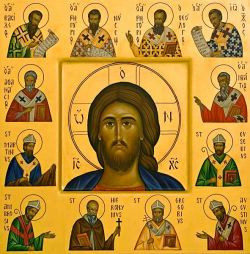Lectio Divina in the experience of Israel and of the Church
In the First Covenant, ancient Israel prayed the Word and used the Word ta pray. You can see these communal practices described in chapter 8 of Nehemiah. This method of explaining and praying the Word is the forerunner of lectio. It became the classic jewish model of prayer and Christianity inherited it (cf. 2 Tm 3:14-16). The New Testament doesn't describe this method so much as make reference to it in several passages.
Generations of Christians continued praying this way, rarely falling finto any form of non-biblical piety or using any prayer that did not recognize the absolute primacy of the Word in the Church's life of prayer. All the Church Fathers, in both East and West, practised this method of lectio divina and encouraged the faithful to do the same in their homes. As a result, they have left us their wonderful commentaries on Scripture, the fruit of their lectio.
And how con we skip over the monastic tradition? The monks made lectio divina the center of their lives both in the desert and in their communities. They called it the ascesis of the monk and his daily bread, for they knew that 'human beings cannot live by bread alone but by every word which comes from the mouth of God' (Dt 8:3 and Mt 4:4). At a certain point, they found it necessary to set this method down in writing to help the novices, who wanted to learn to take the Word into themselves through the Spirit who not only sanctifies but even divinizes them.
Origen proposed theía an a gnosis to the jewish rabbinic school. Saint Jerome punctuated his reading of Scripture with prayer. John Cassian gave an example of meditation. The Carthusian Guigo Il called lectio divina the monks' 'Stairway to Paradise'. Saint Bernard of Clairvaux extolled Scripture as honey on the heart's palate. William of Saint Thierry, in his Golden Epistle and many other works, outlined the method of lectio divina and tried to encourage all Christians to pursue it as the golden way to dialogue and to the ineffable colloquy with God.
This method nourished the faith of whole generations right through the 1300s, and even then Saint Francis of Assisi practised it regularly. But in the High Middle Ages, the scholastic method began to turn lectio divina into lectures on Scripture by introducing the quaestio and the disputatio. During the centuries when lectio as prayer was eclipsed, the way was opened to the more psychological and introspective methods of the devotio moderna and the ignatian forms of meditation. Lectio divina was preserved as a method only in monasteries and among the Servants of Mary. But it was there, waiting to reappear when the Second Vatican Council recommended it in Dei Verbum 25: 'There is a need for all to keep in constant contact with Scripture, using lectio divina . . . , the method of careful meditation, and let all remember that the reading of Scripture should be accompanied by prayer.'
Surely it was the Holy Spirit who willed that this way of listening to the Word and praying over it should not be lost over the centuries.
From: ENZO BIANCHI, Praying the Word, An Introduction to «Lectio Divina»,
Cistercian Publication, Kalamazoo 1998, pp. 85-86.
